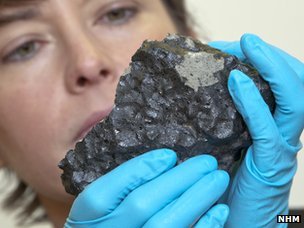
A meteorite from Mars has been given to science to help unravel the Red Planet’s secrets.
The Natural History Museum (NHM) in London has acquired the 1kg piece of the Tissint rock thanks to an anonymous benefactor.
The meteorite was seen to land in Morocco last July and retrieved quickly, resulting in minimal contamination with Earth.
Researchers hope Tissint’s geochemistry will provide insights into past conditions on Mars and the possibility that it may once have hosted life.
Just 61 out of the 41,000 meteorites known to science come from Mars. To get here, they would have been blasted off the surface of the Red Planet by a mighty impact and then travelled through the Solar System before crashing to Earth.
There have only been four other witnessed Martian meteorite falls, the last one in Nigeria in 1962.
“Tissint fell in a dry area, and was picked up soon after it fell and has absolutely minimal contamination,” explained Dr. Caroline Smith, meteorite curator at the NHM.
“It is as if it has just been blasted off Mars. It is effectively a pristine sample of Mars.”

NHM staff will use computed tomography (CT) scans to look at the internal structure of the rock, and perform tests to determine its chemistry.
Researchers will look for minerals formed in the presence of water, and for any signs of organics – carbon-rich molecules.
Energy, water, a source of carbon are the prerequisites for life as we know it. Finding evidence for any of these phenomena in Tissint tells scientists something about how habitable Mars might have been in the past.
This meteorite also contains a lot of glassy material called maskelynite, formed through the force of impact, most probably the blast that ripped it from the surface of Mars.
Scientists will analyze the gas trapped in bubbles in the glass to discern more about the Martian atmosphere.
Indeed, this is how meteorites like Tissint can be tied to the Red Planet – the gases held in the rocks contain types and abundances of atoms that are very similar to the atmosphere sampled by robots on Mars today.
Collectively, the class is known as the SNC group of meteorites, named after three representative members: Shergotty, Nakhla, and Chassigny.
“Looking at similar Mars samples, the ejection date of this sample could range from about 600,000 years ago up to about 17 million years ago,” said Dr. Caroline Smith.
Science would dearly love to retrieve fresh samples of Martian rock for study in Earth labs. The scale and breadth of the analytical techniques that are available in the best-equipped facilities dwarf those which can be deployed on a rover, even a huge (900kg) vehicle like the Curiosity robot just dispatched to the Red Planet by NASA.
But a Mars sample return mission is technically very challenging and would probably cost billions of pounds.
The NHM acquisition has been made possible through the generous support of a private donor.
The donor commented: “My family and I are delighted to partner with the Museum in such an important acquisition. We all now set off on an exciting voyage of discovery. Man may not set foot on Mars in the near future, but Mars has come to us.
“This close-up view will bring new scientific understanding, to spur our children on to further exploration on the surface of the planet itself.”
The rock first came into the possession of Darryl Pitt of the Macovich Collection in New York City. He had heard rumors of its existence over a period of weeks following the observed fall to Earth and had set out to track down its whereabouts. With every lead turning into a dead end, he nearly gave up until he received a helpful phone call.
Darryl Pitt offered it to the NHM with the anonymous benefactor funding the purchase.
“It is both humbling and an honor to be part of this meteorite’s journey, and the Natural History Museum is the perfect final residence,” Darryl Pitt said.